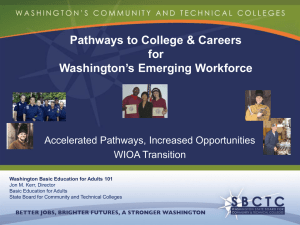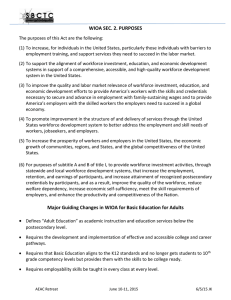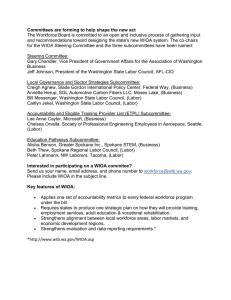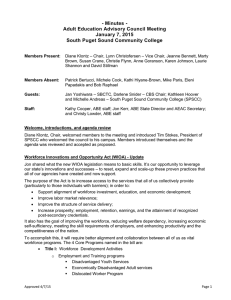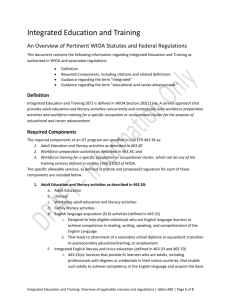Document 15154953
advertisement
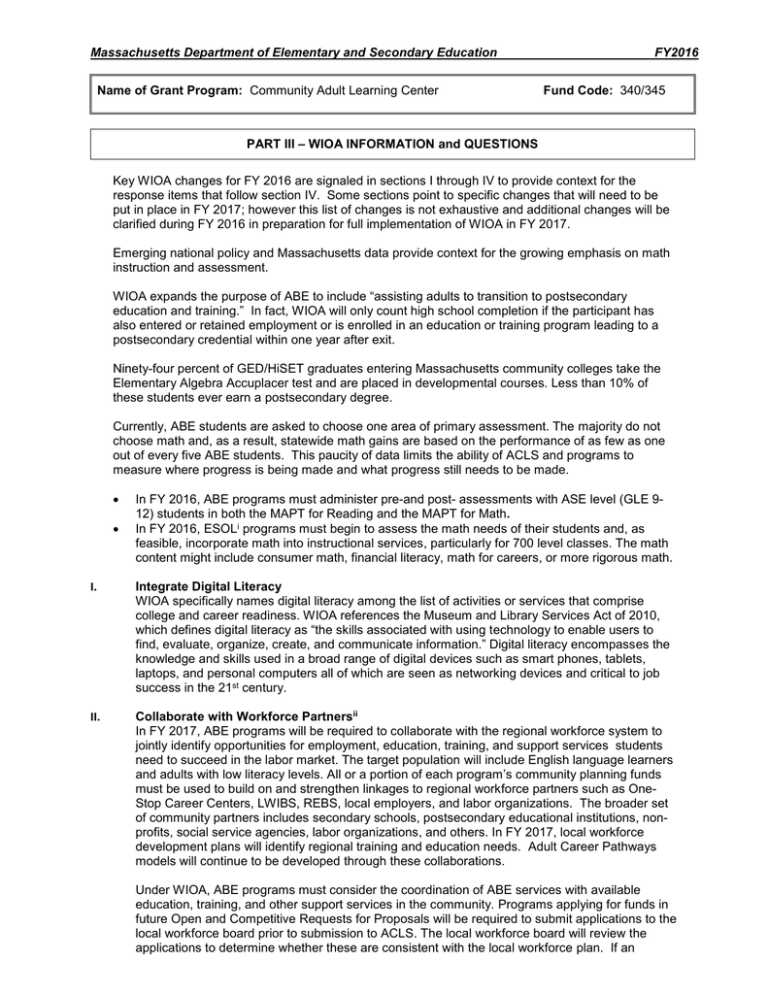
Massachusetts Department of Elementary and Secondary Education Name of Grant Program: Community Adult Learning Center FY2016 Fund Code: 340/345 PART III – WIOA INFORMATION and QUESTIONS Key WIOA changes for FY 2016 are signaled in sections I through IV to provide context for the response items that follow section IV. Some sections point to specific changes that will need to be put in place in FY 2017; however this list of changes is not exhaustive and additional changes will be clarified during FY 2016 in preparation for full implementation of WIOA in FY 2017. Emerging national policy and Massachusetts data provide context for the growing emphasis on math instruction and assessment. WIOA expands the purpose of ABE to include “assisting adults to transition to postsecondary education and training.” In fact, WIOA will only count high school completion if the participant has also entered or retained employment or is enrolled in an education or training program leading to a postsecondary credential within one year after exit. Ninety-four percent of GED/HiSET graduates entering Massachusetts community colleges take the Elementary Algebra Accuplacer test and are placed in developmental courses. Less than 10% of these students ever earn a postsecondary degree. Currently, ABE students are asked to choose one area of primary assessment. The majority do not choose math and, as a result, statewide math gains are based on the performance of as few as one out of every five ABE students. This paucity of data limits the ability of ACLS and programs to measure where progress is being made and what progress still needs to be made. In FY 2016, ABE programs must administer pre-and post- assessments with ASE level (GLE 912) students in both the MAPT for Reading and the MAPT for Math. In FY 2016, ESOLi programs must begin to assess the math needs of their students and, as feasible, incorporate math into instructional services, particularly for 700 level classes. The math content might include consumer math, financial literacy, math for careers, or more rigorous math. I. Integrate Digital Literacy WIOA specifically names digital literacy among the list of activities or services that comprise college and career readiness. WIOA references the Museum and Library Services Act of 2010, which defines digital literacy as “the skills associated with using technology to enable users to find, evaluate, organize, create, and communicate information.” Digital literacy encompasses the knowledge and skills used in a broad range of digital devices such as smart phones, tablets, laptops, and personal computers all of which are seen as networking devices and critical to job success in the 21st century. II. Collaborate with Workforce Partnersii In FY 2017, ABE programs will be required to collaborate with the regional workforce system to jointly identify opportunities for employment, education, training, and support services students need to succeed in the labor market. The target population will include English language learners and adults with low literacy levels. All or a portion of each program’s community planning funds must be used to build on and strengthen linkages to regional workforce partners such as OneStop Career Centers, LWIBS, REBS, local employers, and labor organizations. The broader set of community partners includes secondary schools, postsecondary educational institutions, nonprofits, social service agencies, labor organizations, and others. In FY 2017, local workforce development plans will identify regional training and education needs. Adult Career Pathways models will continue to be developed through these collaborations. Under WIOA, ABE programs must consider the coordination of ABE services with available education, training, and other support services in the community. Programs applying for funds in future Open and Competitive Requests for Proposals will be required to submit applications to the local workforce board prior to submission to ACLS. The local workforce board will review the applications to determine whether these are consistent with the local workforce plan. If an application is not aligned with the local plan, the local workforce board will make recommendations to the program as to how the design may better align with the local workforce plan. III. Integrate Education and Training (IET) In FY 2017, ABE programs will be required to deliver ABE services in conjunction with occupational skills training. The term “integrated education and training” means an approach that provides adult education activities with workforce preparation activities and workforce training for a specific occupation or occupational cluster for the purpose of educational and career advancement. IET requires that ABE services will be offered concurrently and contextually with occupational training. The training will need to target occupations that assist students in their education and career advancement. IV. Integrate English Literacy and Civics Education In FY 2017, ABE programs will have the option to offer English literacy and civics education services that replace the English literacy and civics education program previously authorized under WIA. “Such services shall include instruction in literacy and English language acquisition and instruction on the rights and responsibilities of citizenship and civic participation, and may include workforce training.” Please respond to the following items: A. Integrate Math into higher level ESOL classes 1. Describe how the program will determine the math needs of ESOL students in 700 level (SPLs 6 and 7) classes. 2. Describe how the program will begin to meet the math needs of the ESOL students in 700 level (SPLs 6 and 7) classes. 3. Describe the program design changes needed to support this transition. B. Administer pre- and post- assessments to ASE level students using both the MAPT for Math and the MAPT for Reading. 1. Describe the program design changes needed to support this transition. C. Integrate Digital Literacy 1. Describe how the program is currently integrating digital literacy to prepare students for college and careers. 2. Describe how the program will expand the integration of digital literacy to prepare students for college and careers. D. Collaborate with Workforce Partners On a quarterly basis, the workforce partner in each of the 16 regions convenes the region’s Adult Career Pathways Working Group which consists of the region’s ABE Adult Career Pathways providers, career centers, and other workforce partners. The purpose of the Adult Career Pathways Working Group is to monitor enrollment, program performance, and career development for graduates. All ABE providers are encouraged to strengthen workforce collaborations using the existing structure established by the Adult Career Pathways Working Groups. See the groups by region at this link: http://www.doe.mass.edu/acls/acp/Programs.pdf Programs are encouraged to begin discussions with regional workforce partners as to how they will jointly design and develop a regional approach for concurrent enrollment to deliver integrated education and training. In FY 2017, ABE services will need to be offered concurrently and contextually with occupational training. The training must target occupations that assist students in their education and career advancement and students must be co-enrolled in ABE and skills training. 1. Describe plans to strengthen collaborations with regional workforce partners to jointly identify opportunities for employment, education, training and support services students need to succeed in the labor market. Note that WIOA includes these same opportunities for English language learners, adults with low levels of literacy, and/or individuals facing substantial cultural barriers as other populations currently being served. 2. Describe how the program will use all or a portion of the community planning fundsiii to establish or build collaborations with local workforce partners, such as the workforce board, One-Stop Career Centers, local employers, employment and training programs, and other regional workforce entities as required by WIOA. Note: In FY 2016, programs will be required to submit a continuous improvement plan, including goals, objectives, and major activities. The continuous improvement plan will be due on Friday, December 4, 2015 and should address at least one of the WIOA transition-related activities highlighted in this section. Programs are encouraged to also include one or more WIOA-related curriculum activities. i In WIOA, the term ESOL is replaced with the term English Language Acquisition or ELA. An ESOL program will be referred to as an English Language Acquisition program. ii In WIOA, the workforce system is used to denote the entire system, including core programs, one- stop partner programs, and other programs providing employment and training services as identified by the Massachusetts Workforce Board. iii Programs must determine the amount of community planning funds to establish or build collaborations with the workforce partners as described in Section C.
